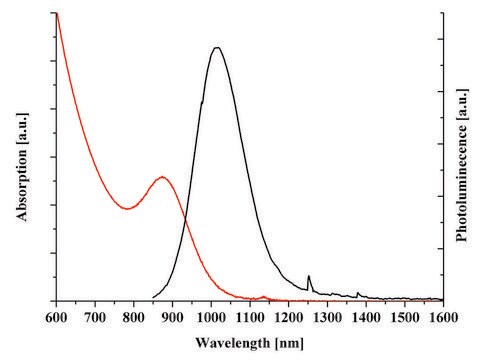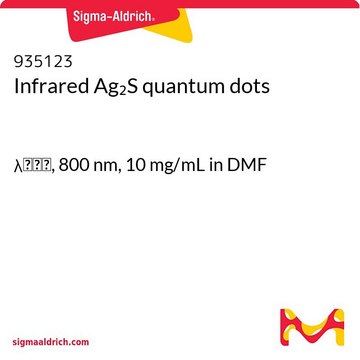900735
PbS core-type quantum dots
oleic acid coated, fluorescence λem 1100 nm, 10 mg/mL in toluene
Sinonimo/i:
Fluorescent nanocrystals, Lead sulfide, PbS QDs
About This Item
Prodotti consigliati
Livello qualitativo
Stato
liquid
Concentrazione
10 mg/mL in toluene
Fluorescenza
λem 1100 nm
Temperatura di conservazione
2-8°C
Stringa SMILE
[Pb].S
InChI
1S/Pb.H2S/h;1H2
MIXDRAMRMDOQJH-UHFFFAOYSA-N
Cerchi prodotti simili? Visita Guida al confronto tra prodotti
Categorie correlate
Applicazioni
Avvertenze
Danger
Indicazioni di pericolo
Consigli di prudenza
Classi di pericolo
Aquatic Chronic 2 - Asp. Tox. 1 - Flam. Liq. 2 - Repr. 1A - Skin Irrit. 2 - STOT RE 2 - STOT RE 2 Inhalation - STOT SE 3
Organi bersaglio
Central nervous system
Codice della classe di stoccaggio
3 - Flammable liquids
Classe di pericolosità dell'acqua (WGK)
WGK 3
Punto d’infiammabilità (°F)
46.4 °F - closed cup
Punto d’infiammabilità (°C)
8 °C - closed cup
Elenchi normativi
Forniamo informazioni su eventuali restrizioni prevalentemente per i prodotti chimici. Per altre tipologie di prodotto siamo in grado di fornire soltanto informazioni limitate. Nessuna segnalazione significa che nessuno dei componenti è citato in un elenco. È dovere dell’utilizzatore assicurarsi che il prodotto venga impiegato in maniera sicura e a norme di legge.
Scegli una delle versioni più recenti:
Certificati d'analisi (COA)
Non trovi la versione di tuo interesse?
Se hai bisogno di una versione specifica, puoi cercare il certificato tramite il numero di lotto.
Possiedi già questo prodotto?
I documenti relativi ai prodotti acquistati recentemente sono disponibili nell’Archivio dei documenti.
Articoli
In this article, the properties of some of the new non-cadmium based QDs along with different applications of QDs are summarized.
Professor Sharma and colleagues review the synthesis and applications of this novel material. This includes a discussion of the unique properties of quantum dots and their suitability for solar cell applications, along with common synthesis techniques used to develop these materials.
Professor Xiaohu Gao (University of Washington, USA) provides a overview of recent quantum dot (QD) advancements and their potential for advancing bioassay and bioimaging technologies.
Dr. Delehanty and researcher introduce recent advances in the use of cadmium-free quantum dots for bioimaging. Focus is placed on strategies that have emerged in the last five years for design, synthesis, and surface modifications of non-Cd quantum dots (QDs) for bioimaging and sensing applications.
Global Trade Item Number
| SKU | GTIN |
|---|---|
| 900735-5ML | 4061833039397 |
Il team dei nostri ricercatori vanta grande esperienza in tutte le aree della ricerca quali Life Science, scienza dei materiali, sintesi chimica, cromatografia, discipline analitiche, ecc..
Contatta l'Assistenza Tecnica.











